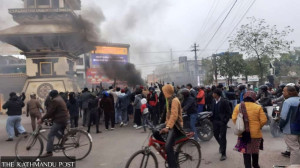National
Department of Archaeology yet to study ruins recovered in Dolakha
The department was informed of the findings a year ago but it has yet to respond to the local unit, say locals.
Rajendra Manandhar
Baiteshwor Rural Municipality’s plan to construct its administrative building in Padudanda hit a snag last year when the construction team discovered the ruins of an ancient human settlement while levelling the ground. The team found structures resembling the walls and pillars of buildings, stone water spouts and ponds during the construction work.
Keeping in view the possible archaeological significance of the ruins, the local unit halted the construction work and informed the Department of Archaeology about the findings. But the department did not respond. The local body shifted the location of the administrative building elsewhere.
“We informed the department immediately after we came across the ruins of a human settlement in Padudanda a year ago. We have yet to hear from the department,” said Chhabi Lama, the chairman of the local unit. According to him, the local body stopped the ground levelling work to protect the ruins.
Padudanda lies near Kiratichhap, a historic place in Dolakha. Noted historian Baburam Acharya had claimed that there was once a Kirati state in the Kiratchhap area since a stone inscription had been recovered there. Lama believes that the ruins of a durbar or any military structures built during the Kirat rule might still be found there.
The site where the ruins have been discovered is about 30km east of Charikot, the district headquarters of Dolakha.
Baiteshwor Rural Municipality has been protecting the Padudanda area believing that it could be a historically and archaeologically significant place. The municipality decided not to construct any structures in the area unless the department carries out a study and submits its report. The people’s representatives and the locals have urged the authorities concerned to excavate the area time and again but to no avail, said Lama.
The rural municipality wants to set up a museum in Padudanda if the archaeological study confirms its historical significance. But for now, all work is on hold for lack of response from the department.
Rabi Chandra Aacharya, the deputy chairman of the local body, said he is positive that the ruins in Padudanda belonged to a durbar or a historic fort.
Bal Kumar Dahal, a local, who also believes in the archaeological significance of the area, said, “The area remains in mystery as the authority is yet to study the ruins,” he said. “We don’t understand the delay on the department’s part.”
According to locals, the land of Padudanda had remained unclaimed for the past 400 years until it was recently handed over to the local unit by the District Land Revenue Office.




 6.3200000000001°C Kathmandu
6.3200000000001°C Kathmandu








%20(1).jpg&w=300&height=200)






